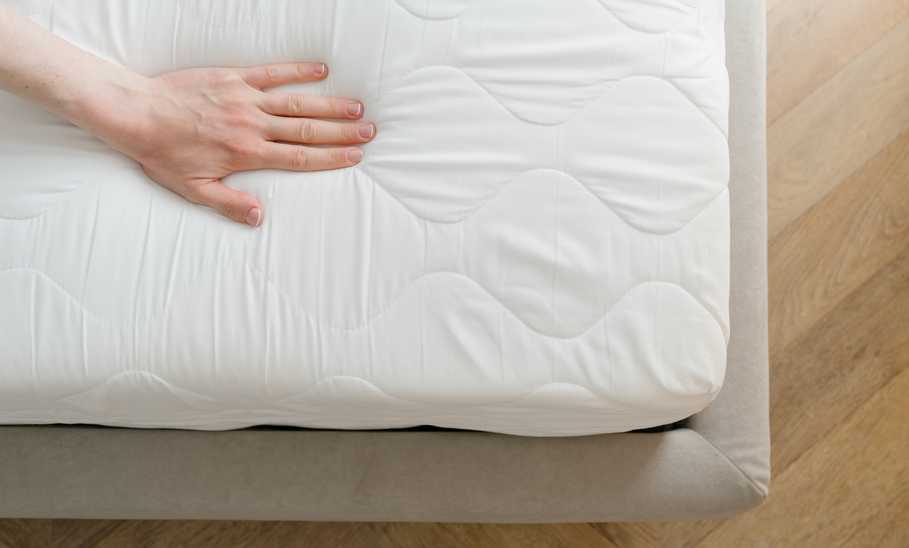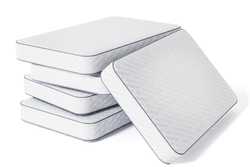How Long Does a Mattress Last? The Signs That Mean It’s Time for a Replacement

Our evaluations and opinions are not influenced by our advertising relationships, but we may earn a commission from our partners’ links. This content is created by TIME Stamped, under TIME’s direction and produced in accordance with TIME’s editorial guidelines and overseen by TIME’s editorial staff. Learn more about it.
If you get eight full hours of sleep at night but you still feel groggy the next day, your old mattress may be the culprit. A mattress may seem perfectly fine on the outside, but inside, the support system may be breaking down without you even realizing it. Perhaps you’ve noticed your sleep isn’t as restful as it once was—and you’re wondering just how long a mattress lasts? Fortunately, there are signs you can look for with your mattress to let you know it’s time for considering a replacement. While mattresses are designed to last for years, they don’t last forever, and getting quality sleep is a critical component of our overall health and well-being.
On average, you should expect to replace a mattress after five to 10 years of use. But this number can increase or decrease tremendously based on the quality, care, and type of mattress.


A memory foam mattress can last up to 10 years. (You’ll also know it’s time to replace a memory foam mattress when it starts sagging.) Quality is key for extending the life of memory foam mattresses, including multiple layers of dense foam.
Hybrid mattresses, which combine both memory foam and innersprings, last an average of seven to 10 years. Like a memory-foam mattress, if it’s older than 10 years, it’s most likely in need of replacement.
Innerspring mattresses have the shortest lifespan of the various mattress types. On average, you can expect these to last six to eight years. It includes a series of coils, made of various grades of metal. These mattresses are more firm and offer localized support on your body, but coils tend to break down easily.
Latex is typically the longest lasting type of mattress, averaging 10 to 12 years. It’s produced with natural materials, which lengthens the lifespan when it’s cared for properly.
| Mattress type | Average lifespan | Firmness | Best for |
|---|---|---|---|
Memory foam | 7 to 10 years | Soft to medium | You want to feel more enclosed, help with painful joints |
Hybrid | 7 to 10 years | Medium | When you need both softness and support, couples who have varying sleep needs |
Innerspring | 6 to 8 years | Medium to firm | Budget options, need greater back support |
Latex | 10 to 12 years | Medium | More bounce and give, eco-friendly option |
There are a few preventative measures you can take to get the most life out of your mattress.
Your mattress may develop uneven wear over time, which leads to sagging and overall discomfort. You can flip the mattress and rotate it 180 degrees at least twice a year, which helps improve the weight distribution over time.
A good mattress protector not only protects your mattress from dust, allergens, spills, and stains, it also creates a barrier between your body, your sheets, and your mattress. This helps keep your mattress cleaner and more hygienic for a longer period of time.
Regularly vacuuming and cleaning up stains on your mattress right away is important. It’s a way to remove the dust and allergen build-up and prevent moisture from getting into the mattress. You can even sprinkle baking soda on the mattress occasionally before vacuuming, which helps deodorize it, too.
Make sure you have the right support for your mattress too, by choosing a wood or metal frame that supports your mattress. You want a sturdy base that aids in proper weight distribution, which can extend the life of the mattress.
Sorry kids, we hate to break it to you but too much bouncing on the bed can quickly damage your parents’ mattress. It can not only damage the mattress over time, but also damage the box spring underneath it, due to the extra pressure from bouncing.
The lifespan of your mattress depends on multiple factors. For starters, the quality of materials is a major influencer. Innerspring coils and all-foam mattresses typically have the shortest durability, which leads to sagging and the general breaking down of the mattress. If you opt for more durable materials, such as a hybrid with higher-density foam or latex options, you can expect a longer lifespan with proper care.
Maintenance and care is another big one. Mattress manufacturers recommend flipping and rotating the mattress regularly and using a mattress protector to help prolong the lifespan.
The weight on the mattress is another factor too. A mattress will likely need replacement sooner if a couple sleeps on it regularly, versus one person. Extra weight from children and pets can also cause more stains and damage to the mattress, which shortens the lifespan.
The age of the mattress is one indicator, but your body and other signs of a worn-out mattress will let you know it’s time for a replacement. Look for these clues if you’re wondering how much longer your mattress should last.
If you are injury-free or aren’t engaging in strenuous exercise and you wake up in pain or feeling achy, chances are it’s from your mattress. You may feel a stiff neck, sore back, or even pinched nerves. If the pain typically resolves throughout the day, you know you’re likely dealing with an old mattress.
Over time, your mattress can trap dust mites and allergens, which means you’re breathing it in every night. If you wake up with watery eyes, a stuffy nose, or any other allergy-like symptoms, then your mattress may be to blame.
Additionally, your mattress may have a funny odor to it, which can be a sign of mold or mildew buildup. If you try cleaning your mattress or disinfecting it first, but it doesn’t help, then this may be the cause.
Sagging is an obvious sign it’s time for replacement. The sagging may occur in the middle or on the corners, but either way, it’s a no-go if you want more restful sleep. Worn edges, rips, and tears are other signs of mattress distress. Your mattress may look old from these, with or without the presence of sagging.
Your mattress should feel smooth and flat, which is essential for proper weight distribution while you sleep. Any lumps or indentations may be from a broken innerspring and it’s another sign that it’s time for replacement.
It’s common for memory foam mattresses to form “impressions” over time too, since the foam eventually wears out and doesn’t maintain the right shape.
A mattress shouldn’t squeak or pop, so if it does, then it’s likely time for a replacement. This is more common in coil mattresses or hybrid mattresses which include inner springs, but it’s a definite sign of wear.
A more obvious sign is if you sleep better in someone’s guest bed or a hotel and feel more rested and refreshed than how you feel with your own bed. You want your home to be the place you get the most comfortable sleep, considering the number of hours you spend sleeping there each week.
Quality sleep is a critical component of a healthier lifestyle, so what happens when an old mattress keeps you from getting the rest you need? It’s possible an old mattress can cause:
Quality sleep is one of the benchmarks of our health. We need sleep to rejuvenate our bodies and minds. When you don’t have regular, restful sleep, it increases the risk of disease and disorders, according to the National Heart, Lung, and Blood Institute. Better sleep leads to improved brain performance and mood, making our mattresses a key component of a healthier lifestyle and is worth the investment if needed.
Once you start shopping for a mattress you may quickly realize how many choices there are, making it easy to get overwhelmed. There are a few tips to follow that can help you with the selection process though, so you can start sleeping like a baby once again.
There are four main mattress types:
Knowing the main differences between the mattresses can help you narrow down your options and potential retailers.
As mentioned above, certain mattress types are more suitable for certain sleeping positions, as well as the firmness level. If you’re a back sleeper, you likely need a medium level of firmness, whereas side sleepers may prefer softer firmness so it easily contours with their bodies. Stomach sleepers may need an ultra-firm mattress, offering the greatest support for their hips and shoulders.
Firmness is also important based on your bodyweight. Those with heavier body weights may find a firmer mattress is better, while a lightweight person is typically better suited for a softer firmness. A medium firmness level is also a feature of the best mattress for back pain.
When shopping for a mattress, you’ll quickly find how much the prices vary, so keep this in mind before you start testing mattresses. And while it may be tempting to choose the least expensive option, with mattresses, you often get what you pay for. Ultimately, you want to choose something affordable but gives you the best sleep possible for your lifestyle. You should also consider any extras—like mattress pads or protectors—as part of your overall budget as well. To save the most money, consider making your purchase during one of the best times to buy a mattress (like Memorial Day, Labor Day, Black Friday, and Presidents’ Day).
The average lifespan of a mattress is seven to 10 years, but this depends on numerous factors. The quality of a mattress, how well it’s been cared for, the number of sleepers and bodyweight, plus the type of mattress all influence how long or short the lifespan is.
A latex mattress generally has the longest lifespan among the various types of mattresses. On average, you can expect a latex mattress to last between 10 to 12 years, versus the typical seven to 10 years of most others. This time frame may increase or decrease depending on how well it’s cared for, but you can attribute its durability to the natural materials used.
It’s possible a mattress can last 20 years if it’s been well cared for. Keep in mind though, mattresses need regular replacement as they often break down due to wear and tear, some of which might be as noticeable.
It depends on the materials and how well it’s made, but with proper care you can expect a mattress topper to last an average of three to five years.
The information presented here is created by TIME Stamped and overseen by TIME editorial staff. To learn more, see our About Us page.



